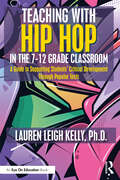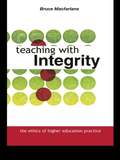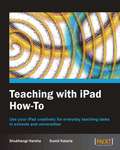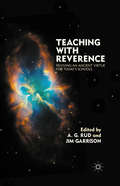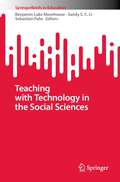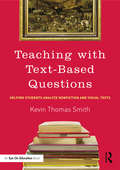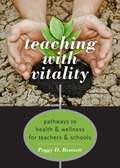- Table View
- List View
Teaching with Emotional Intelligence: A step-by-step guide for Higher and Further Education professionals
by Alan MortiboysThe way teachers shape and handle their own feelings and those of their learners is central to the success of learning. Now in its second edition, Teaching with Emotional Intelligence shows how to manage this influential yet neglected area of learning and teaching. This practical book looks at how lecturers and teachers can develop and use their emotional intelligence to enhance their teaching and their students’ learning. Taking the reader step-by-step through the learning process and looking at the relationship from the perspective of both the teacher and the learner, this book will help the reader to: plan the emotional environment; learn how to relate and listen to learners effectively; read and respond to the feelings of individuals and groups; handle and reveal their feelings as a teacher, as appropriate; develop self-awareness as a teacher; recognise their prejudices and preferences; improve non-verbal communication; plan for the physical experience of learners; deal with their learners’ expectations, comments and questions. This book contains a number of revised activities, checklists and points for deeper reflection as well as new chapters on teaching with emotional intelligence with international students, in online learning and in working one-to-one with students. It will help all teaching professionals encourage their learners to become more engaged, creative, positive and motivated.
Teaching With Google Classroom - Second Edition: Save Time And Stay Organized While Delivering Online And In-person Classes
by Michael ZhangSave time and stay organized while delivering online and in-person classes
Teaching with Hip Hop in the 7-12 Grade Classroom: A Guide to Supporting Students’ Critical Development Through Popular Texts
by Lauren Leigh KellyThis book presents practical approaches for engaging with Hip Hop music and culture in the classroom. As the most popular form of music and youth culture today, Hip Hop is a powerful medium through which students can explore their identities and locate themselves in our social world. Designed for novice and veteran teachers, this book is filled with pedagogical tools, strategies, lesson plans, and real-world guidance on integrating Hip Hop into the curriculum. Through a wide range of approaches and insights, Lauren Leigh Kelly invites teachers to look to popular media culture to support students’ development and critical engagement with texts. Covering classroom practice, assessment strategies, and curricular and standards-based guidelines, the lessons in this book will bolster students’ linguistic and critical thinking skills and help students to better understand and act upon the societal forces around them. The varied activities, assignments, and handouts are designed to inspire teachers and easily facilitate modification of the assignments to suit their own contexts. The impact of Hip Hop on youth culture is undeniable, now more than ever; this is the perfect book for teachers who want to connect with their students, support meaning-making in the classroom, affirm the validity of youth culture, and foster an inclusive and engaging classroom environment.
Teaching with Hip Hop in the 7-12 Grade Classroom: A Guide to Supporting Students’ Critical Development Through Popular Texts
by Lauren Leigh KellyThis book presents practical approaches for engaging with Hip Hop music and culture in the classroom. As the most popular form of music and youth culture today, Hip Hop is a powerful medium through which students can explore their identities and locate themselves in our social world. Designed for novice and veteran teachers, this book is filled with pedagogical tools, strategies, lesson plans, and real-world guidance on integrating Hip Hop into the curriculum. Through a wide range of approaches and insights, Lauren Leigh Kelly invites teachers to look to popular media culture to support students’ development and critical engagement with texts. Covering classroom practice, assessment strategies, and curricular and standards-based guidelines, the lessons in this book will bolster students’ linguistic and critical thinking skills and help students to better understand and act upon the societal forces around them. The varied activities, assignments, and handouts are designed to inspire teachers and easily facilitate modification of the assignments to suit their own contexts. The impact of Hip Hop on youth culture is undeniable, now more than ever; this is the perfect book for teachers who want to connect with their students, support meaning-making in the classroom, affirm the validity of youth culture, and foster an inclusive and engaging classroom environment.
Teaching with Influence
by Peter Hook Andy VassThis book brings together a range of powerful beliefs and strategies to enhance the personal development and self-esteem of teachers. It explores practical ways in which teachers can increase their effectiveness and enhance the learning climate in their classrooms, and focuses on the most important resource teachers have - themselves!
Teaching with Influence
by Peter Hook Andy VassThis book brings together a range of powerful beliefs and strategies to enhance the personal development and self-esteem of teachers. It explores practical ways in which teachers can increase their effectiveness and enhance the learning climate in their classrooms, and focuses on the most important resource teachers have - themselves!
Teaching with Integrity: The Ethics of Higher Education Practice
by Bruce MacfarlaneThis is a book about the ethics of teaching in the context of higher education. While many books focus on the broader socially ethical topics of widening participation and promoting equal opportunities, this unique book concentrates specifically on the lecturer's professional responsibilities. It covers the real-life, messy, everyday moral dilemmas that confront university teachers when dealing with students and colleagues - whether arising from facilitated discussion in the classroom, deciding whether it is fair to extend a deadline, investigating suspected plagiarism or dealing with complaints. Bruce Macfarlane analyses the pros and cons of prescriptive professional codes of practice employed by many universities and proposes the active development of professional virtues over bureaucratic recommendations. The material is presented in a scholarly, yet accessible style, and case examples are used throughout to encourage a practical, reflective approach.Teaching With Integrity seeks to bridge the pedagogic gap currently separating the debate about teaching and learning in higher education from the broader social and ethical environment in which it takes place.
Teaching with Integrity: The Ethics of Higher Education Practice
by Bruce MacfarlaneThis is a book about the ethics of teaching in the context of higher education. While many books focus on the broader socially ethical topics of widening participation and promoting equal opportunities, this unique book concentrates specifically on the lecturer's professional responsibilities. It covers the real-life, messy, everyday moral dilemmas that confront university teachers when dealing with students and colleagues - whether arising from facilitated discussion in the classroom, deciding whether it is fair to extend a deadline, investigating suspected plagiarism or dealing with complaints. Bruce Macfarlane analyses the pros and cons of prescriptive professional codes of practice employed by many universities and proposes the active development of professional virtues over bureaucratic recommendations. The material is presented in a scholarly, yet accessible style, and case examples are used throughout to encourage a practical, reflective approach.Teaching With Integrity seeks to bridge the pedagogic gap currently separating the debate about teaching and learning in higher education from the broader social and ethical environment in which it takes place.
Teaching with Intention: Defining Beliefs, Aligning Practice, Taking Action, K-5
by Debbie MillerEffective, intentional teaching begins with a strong set of beliefs, but even the best teachers -- including author Debbie Miller -- struggle to make sure that their classroom practice consistently reflects their core convictions. In Teaching with Intention: Defining Beliefs, Aligning Practice, Taking Action, K-5, Miller defines her actions to ensure that children are the true beneficiaries of her teaching. As Peter Johnston writes, Through this book we have Debbie's teaching mind on loan. She engages us in the details of a teaching life from inside her mind, showing the thinking behind her teaching and the consequences of her actions.Teaching with Intention brings us into classrooms of teachers and children Miller has met over the last five years in her work as a literacy consultant. From setting up the classroom environment to the intentional use of language, from comprehension instruction to lesson design, Miller is explicit about what she does and why. At the same time, she encourages teachers to develop their own belief statements concerning teaching and learning and includes key questions to guide them in this important process.In an environment where the handing down of scripted programs and foolproof curricula is increasingly the norm, Teaching with Intention offers a compelling reminder that truly transformative teaching is built from the ground up, and is rebuilt every year, by every teacher, in every classroom, with every new group of students.
Teaching with Intention: Defining Beliefs, Aligning Practice, Taking Action, K-5
by Debbie MillerEffective, intentional teaching begins with a strong set of beliefs, but even the best teachers -- including author Debbie Miller -- struggle to make sure that their classroom practice consistently reflects their core convictions. In Teaching with Intention: Defining Beliefs, Aligning Practice, Taking Action, K-5, Miller defines her actions to ensure that children are the true beneficiaries of her teaching. As Peter Johnston writes, Through this book we have Debbie's teaching mind on loan. She engages us in the details of a teaching life from inside her mind, showing the thinking behind her teaching and the consequences of her actions.Teaching with Intention brings us into classrooms of teachers and children Miller has met over the last five years in her work as a literacy consultant. From setting up the classroom environment to the intentional use of language, from comprehension instruction to lesson design, Miller is explicit about what she does and why. At the same time, she encourages teachers to develop their own belief statements concerning teaching and learning and includes key questions to guide them in this important process.In an environment where the handing down of scripted programs and foolproof curricula is increasingly the norm, Teaching with Intention offers a compelling reminder that truly transformative teaching is built from the ground up, and is rebuilt every year, by every teacher, in every classroom, with every new group of students.
Teaching with iPad How-To
by Shubhangi Harsha Sumit KatariaTeaching with iPad how-to is a crisp and systematic guide organized into various step-by-step recipes that will enable you to utilize the power of your iPad to make your daily teaching tasks easy and interesting. This book is ideal for school and university teachers who have access to an iPad and are willing to make their profession all the more fun and easy for themselves. It is assumed that the reader has basic knowledge of how to use the iPad, access the Appstore and download apps.
Teaching with Reverence: Reviving an Ancient Virtue for Today's Schools
by A. Rud J. GarrisonReverence is a forgotten virtue in teaching and learning. When taken in a broader spiritual sense, it is often associated with a mute and prim solemnity. The essays gathered here examine reverence as a way to understand some of the spiritual dimensions of classroom teaching.
Teaching with Sociological Imagination in Higher and Further Education: Contexts, Pedagogies, Reflections
by Christopher R. Matthews Ursula Edgington Alex ChannonThis book uses research and personal stories from university lecturers to explore pedagogical strategies that illuminate how students’ minds can be ‘switched on’ in order to unlock their extraordinary potential. It presents diverse ways to create inspiring learning environments, in chapters written by internationally respected experts in the broad field of the social sciences. Each author illustrates how – through their unique teaching philosophies and practices – they seek to enhance students’ experiences and promote their critical thinking, learning and development. The respective chapters provide conceptual arguments, personal insights and practical examples from a broad range of classrooms, demonstrating various ways in which students’ sociological imagination can be brought to life. As such, the book is both practical and theoretical, and is primarily aimed at educators working in both higher and further education institutions who wish to develop their understanding of classroom pedagogy as well as gain practical ideas for teaching and learning in the social sciences.
Teaching with Tablets
by Ms Helen Caldwell James BirdThe presence of handheld technologies in the classroom isn't enough - you need to know how to use them to enhance teaching and transform learning. As more and more primary schools acquire devices such as iPads and tablets, it is becoming clear that adding them as a classroom resource is not enough. Teachers and trainees need strategies to integrate these into existing learning contexts in a meaningful way. Without this, these fantastic resources lose their value. This book helps teachers to make the most of these devices in the primary classroom. It offers guidance on: how to use tablets to devise meaningful learning activities embed them in genuine curriculum contexts, drawing upon case studies from existing practice It is written for non-specialists and explains technical terms in an accessible, practical way. Each chapter begins with a case study contributed by a teacher using tablets in schools. Real life examples and comments like this give the text a truly practical focus. Check out the book's Pinterest board which includes the apps mentioned in the book as well as a handy infographic for a snapshot guide on starting off your tablet teaching journey. A note from the authors The use of technology in schools continues to evolve rapidly as new devices and tools become available, and the adoption of mobile devices such as iPads and tablets has been a particularly exciting development in recent years. The benefits offered by these technologies, such as their portability, connectivity, accessibility and range of media, present new challenges and opportunities for teaching and learning. As the take up of tablets gathers pace in our schools there is a need for advice on the best approaches and apps to help achieve successful learning outcomes. Teachers need to find meaningful ways to integrate the devices into their own practice and to evaluate which of the many thousands of educational apps might be appropriate for their pupils. This book considers how iPads and tablets can be used to enhance teaching and learning in primary schools. It is especially relevant in the light of the computing curriculum, which puts a new emphasis on children as makers and creators of digital content. Across other curriculum subjects too, the introduction of mobile devices that can be quickly and reliably accessed has precipitated a shift in practice. For example, they have enabled teachers and children to spontaneously pursue lines of inquiry, to connect, collaborate and publish in many different ways, and to use their digital skills to enhance their exploration of the physical world outside the classroom. With these opportunities in mind, we offer anecdotes from the classroom and examples of how tablets might be embedded within current pedagogy and practice as a natural learning tool. Each chapter combines a practical case study with discussion of related pedagogy, and recommends apps to support a personalised, inclusive and active approach to teaching and learning.
Teaching with Tablets (PDF)
by James Bird Ms Helen CaldwellThe presence of handheld technologies in the classroom isn't enough - you need to know how to use them to enhance teaching and transform learning. As more and more primary schools acquire devices such as iPads and tablets, it is becoming clear that adding them as a classroom resource is not enough. Teachers and trainees need strategies to integrate these into existing learning contexts in a meaningful way. Without this, these fantastic resources lose their value. This book helps teachers to make the most of these devices in the primary classroom. It offers guidance on: how to use tablets to devise meaningful learning activities embed them in genuine curriculum contexts, drawing upon case studies from existing practice It is written for non-specialists and explains technical terms in an accessible, practical way. Each chapter begins with a case study contributed by a teacher using tablets in schools. Real life examples and comments like this give the text a truly practical focus. Check out the book's Pinterest board which includes the apps mentioned in the book as well as a handy infographic for a snapshot guide on starting off your tablet teaching journey. A note from the authors The use of technology in schools continues to evolve rapidly as new devices and tools become available, and the adoption of mobile devices such as iPads and tablets has been a particularly exciting development in recent years. The benefits offered by these technologies, such as their portability, connectivity, accessibility and range of media, present new challenges and opportunities for teaching and learning. As the take up of tablets gathers pace in our schools there is a need for advice on the best approaches and apps to help achieve successful learning outcomes. Teachers need to find meaningful ways to integrate the devices into their own practice and to evaluate which of the many thousands of educational apps might be appropriate for their pupils. This book considers how iPads and tablets can be used to enhance teaching and learning in primary schools. It is especially relevant in the light of the computing curriculum, which puts a new emphasis on children as makers and creators of digital content. Across other curriculum subjects too, the introduction of mobile devices that can be quickly and reliably accessed has precipitated a shift in practice. For example, they have enabled teachers and children to spontaneously pursue lines of inquiry, to connect, collaborate and publish in many different ways, and to use their digital skills to enhance their exploration of the physical world outside the classroom. With these opportunities in mind, we offer anecdotes from the classroom and examples of how tablets might be embedded within current pedagogy and practice as a natural learning tool. Each chapter combines a practical case study with discussion of related pedagogy, and recommends apps to support a personalised, inclusive and active approach to teaching and learning.
Teaching with Tasks for Effective Mathematics Learning (Mathematics Teacher Education #104)
by Peter Sullivan Doug Clarke Barbara ClarkeThis book is about how teachers can use classroom mathematics tasks to support student learning, and presents data on the ways in which teachers used those tasks in a particular research project. It is the product of research findings focusing on teacher practice, teacher learning and knowledge, and student learning. It demonstrates how teachers can use mathematics tasks to promote effective student learning.
Teaching with Technology in the Social Sciences (SpringerBriefs in Education)
by Benjamin Luke Moorhouse Sandy S. C. Li Sebastian PahsIn 2021, the University Grants Committee of Hong Kong, the funding body for higher education in Hong Kong, initiated a scheme and associated grant fund with the aim of enhancing the use of technology for teaching in higher education institutions in Hong Kong. In the Faculty of Social Sciences, Hong Kong Baptist University, the funding was used to support colleagues in various disciplines to develop teaching and learning projects that capitalized on technology to improve the educational experiences of students. In this book, seven project teams from five disciplines, Education, Geography, History, Social Work, and Sociology, share their technological innovations. Each chapter presents the design, implementation, challenges, benefits, and impact on student learning and experiences of each innovative project. Lecturers, professors and curriculum designers engaged in teaching and learning will find this book an invaluable resource as it provides ways to integrate technology into their teaching practices. Scholars of teaching and learning (SoTL) will also find the book a useful reference for up-to-date technological and pedagogical practices in the social science disciplines.
Teaching With Text-Based Questions: Helping Students Analyze Nonfiction and Visual Texts
by Kevin Thomas SmithHelp your students navigate complex texts in history/social studies and English language arts! This book shows you how to use a key tool—text-based questions—to build students’ literacy and critical thinking skills and meet the Common Core State Standards. You’ll learn how to ask text-based questions about different types of nonfiction and visual texts, including primary and secondary sources, maps, charts, and paintings. You’ll also get ideas for teaching students to examine point of view, write analytical responses, compare texts, cite textual evidence, and pose their own high-level questions. The book is filled with examples that you can use immediately or modify as needed. Each chapter ends with a reflection section to help you adapt the ideas to your own classroom. What’s Inside: Helpful information on teaching different types of nonfiction texts, including literary nonfiction, informational texts, primary and secondary sources, and visual texts Ideas for locating primary sources Questions students should ask about every text Techniques for soliciting higher-order questions from students Ways to get students to think critically about the relationships between texts Strategies to help students integrate information from different types of sources, a skill that will help students respond to performance tasks on the PARCC and SBAC assessments and DBQs on AP exams Tips for teaching students to write good responses to text-based questions, including how to cite sources and incorporate point of view Ideas for using rubrics and peer grading to evaluate students’ responses Connections to the informational reading standards of the Common Core State Standards for English Language Arts for grades 3-12 and of the Common Core State Standards for Literacy in History/Social Studies, Science, and Technical Subjects
Teaching With Text-Based Questions: Helping Students Analyze Nonfiction and Visual Texts
by Kevin Thomas SmithHelp your students navigate complex texts in history/social studies and English language arts! This book shows you how to use a key tool—text-based questions—to build students’ literacy and critical thinking skills and meet the Common Core State Standards. You’ll learn how to ask text-based questions about different types of nonfiction and visual texts, including primary and secondary sources, maps, charts, and paintings. You’ll also get ideas for teaching students to examine point of view, write analytical responses, compare texts, cite textual evidence, and pose their own high-level questions. The book is filled with examples that you can use immediately or modify as needed. Each chapter ends with a reflection section to help you adapt the ideas to your own classroom. What’s Inside: Helpful information on teaching different types of nonfiction texts, including literary nonfiction, informational texts, primary and secondary sources, and visual texts Ideas for locating primary sources Questions students should ask about every text Techniques for soliciting higher-order questions from students Ways to get students to think critically about the relationships between texts Strategies to help students integrate information from different types of sources, a skill that will help students respond to performance tasks on the PARCC and SBAC assessments and DBQs on AP exams Tips for teaching students to write good responses to text-based questions, including how to cite sources and incorporate point of view Ideas for using rubrics and peer grading to evaluate students’ responses Connections to the informational reading standards of the Common Core State Standards for English Language Arts for grades 3-12 and of the Common Core State Standards for Literacy in History/Social Studies, Science, and Technical Subjects
Teaching with Vitality: Pathways to Health and Wellness for Teachers and Schools
by Peggy D. BennettPerhaps more than any other experience, conflict in schools and workplaces can zap our energy and steal our vigor as teachers. If we knew ways to minimize conflict and maximize vitality, would we use them? Teaching with Vitality offers specific behaviors and attitudes to reframe conflict by diluting and dissolving it. Organized into brief topics for busy readers, Teaching with Vitality combines common experiences and practical options for lessening the turmoil that is inevitable in schools. As beneficent stewards of our children, educators are priceless contributors to the quality of our lives. The main goal of Teaching with Vitality is to elevate teachers in their day-to-day lives by deconstructing the major and minor conflicts that sap their peace and dampen their power. School wellness is contagious. And, this book aims to offer daily pathways to health, wellness, and vigor.
Teaching with Vitality: Pathways to Health and Wellness for Teachers and Schools
by Peggy D. BennettPerhaps more than any other experience, conflict in schools and workplaces can zap our energy and steal our vigor as teachers. If we knew ways to minimize conflict and maximize vitality, would we use them? Teaching with Vitality offers specific behaviors and attitudes to reframe conflict by diluting and dissolving it. Organized into brief topics for busy readers, Teaching with Vitality combines common experiences and practical options for lessening the turmoil that is inevitable in schools. As beneficent stewards of our children, educators are priceless contributors to the quality of our lives. The main goal of Teaching with Vitality is to elevate teachers in their day-to-day lives by deconstructing the major and minor conflicts that sap their peace and dampen their power. School wellness is contagious. And, this book aims to offer daily pathways to health, wellness, and vigor.
Teaching Without Bells: What We Can Learn from Powerful Practice in Small Schools
by Joey FeldmanSmall schools have the potential to fundamentally change the conditions of teaching and learning when practitioners deliberately exploit smallness and recognize relationships as a powerful mechanism for improving student achievement. Feldman explains the dynamics of teaching in a small high school--what having fewer students in a school affords teachers, as well as the challenges for teaching that exist alongside the opportunities--based on research, teacher interviews, and the author's own experiences as a practitioner in both small and large schools. This book is for any educator or researcher who wants to better understand the kind of promising practices and professional norms that have been nurtured under conditions of smallness. Being informed about what is possible and often facilitated in small schools will enable educators to better reflect on their own practice, consider certain pedagogical strategies against the organizational characteristics of schools, and make educated career choices. Armed with this information, educators and researchers can become more focused in their advocacy efforts and more empowered to improve our public high schools whether by redesigning them into small schools or by transplanting and translating small school practices and strategies."
Teaching Without Bells: What We Can Learn from Powerful Practice in Small Schools (Teacher's Toolkit Ser.)
by Joey FeldmanSmall schools have the potential to fundamentally change the conditions of teaching and learning when practitioners deliberately exploit smallness and recognize relationships as a powerful mechanism for improving student achievement. Feldman explains the dynamics of teaching in a small high school--what having fewer students in a school affords teachers, as well as the challenges for teaching that exist alongside the opportunities--based on research, teacher interviews, and the author's own experiences as a practitioner in both small and large schools. This book is for any educator or researcher who wants to better understand the kind of promising practices and professional norms that have been nurtured under conditions of smallness. Being informed about what is possible and often facilitated in small schools will enable educators to better reflect on their own practice, consider certain pedagogical strategies against the organizational characteristics of schools, and make educated career choices. Armed with this information, educators and researchers can become more focused in their advocacy efforts and more empowered to improve our public high schools whether by redesigning them into small schools or by transplanting and translating small school practices and strategies."
Teaching Without Disruption in the Primary School: A practical approach to managing pupil behaviour
by Roland ChaplainThe issue of behaviour has, and always will be, a main dilemma facing schools. Encouraging positive relationships whilst preventing disruption, and motivating students to learn, raises concerns for any teacher. This fully updated second edition of Teaching without Disruption in the Primary School offers a comprehensive and constructive approach to developing effective behaviour management. Packed full of tasks, case studies, and research-based guidance, this extremely practical book reflects high quality behaviour management training and is crucially informed by empirical evidence on exactly what works in classrooms and schools. Containing two brand new chapters - one on the importance of theory in developing effective behaviour management, and the other detailing a toolkit for constructing effective classroom management plans - the book presents a model for developing: effective behaviour management at the individual pupil, classroom and whole school level professional social skills, assertiveness and coping strategies understanding of how teachers’ thinking and behaviour can unwittingly affect pupil behaviour a roadmap for establishing and maintaining authority pupils’ self-control and social competence using a cognitive-behavioural approach an appreciation of the value of adopting a research-based approach to behaviour management. Roland Chaplain has used this programme to successfully teach behaviour management techniques to thousands of PGCE trainees at the University of Cambridge, UK. Underpinned by contemporary educational, psychological and neuroscientific research, this book offers a progressively focused behaviour management model which will appeal to all teachers and teacher trainees, as well as to those who train them.
Teaching Without Disruption in the Primary School: A practical approach to managing pupil behaviour
by Roland ChaplainThe issue of behaviour has, and always will be, a main dilemma facing schools. Encouraging positive relationships whilst preventing disruption, and motivating students to learn, raises concerns for any teacher. This fully updated second edition of Teaching without Disruption in the Primary School offers a comprehensive and constructive approach to developing effective behaviour management. Packed full of tasks, case studies, and research-based guidance, this extremely practical book reflects high quality behaviour management training and is crucially informed by empirical evidence on exactly what works in classrooms and schools. Containing two brand new chapters - one on the importance of theory in developing effective behaviour management, and the other detailing a toolkit for constructing effective classroom management plans - the book presents a model for developing: effective behaviour management at the individual pupil, classroom and whole school level professional social skills, assertiveness and coping strategies understanding of how teachers’ thinking and behaviour can unwittingly affect pupil behaviour a roadmap for establishing and maintaining authority pupils’ self-control and social competence using a cognitive-behavioural approach an appreciation of the value of adopting a research-based approach to behaviour management. Roland Chaplain has used this programme to successfully teach behaviour management techniques to thousands of PGCE trainees at the University of Cambridge, UK. Underpinned by contemporary educational, psychological and neuroscientific research, this book offers a progressively focused behaviour management model which will appeal to all teachers and teacher trainees, as well as to those who train them.


